Indonesian Corn Fritters (also known as bakwan jagung or perkedel jagung) are surprisingly easy to make with everyday ingredients. Packed with juicy corn kernels and zingy flavour from kaffir lime and ground spices, these Indonesian corn fritters are crispy, crunchy perfection! Includes delicious dipping sauce ideas.
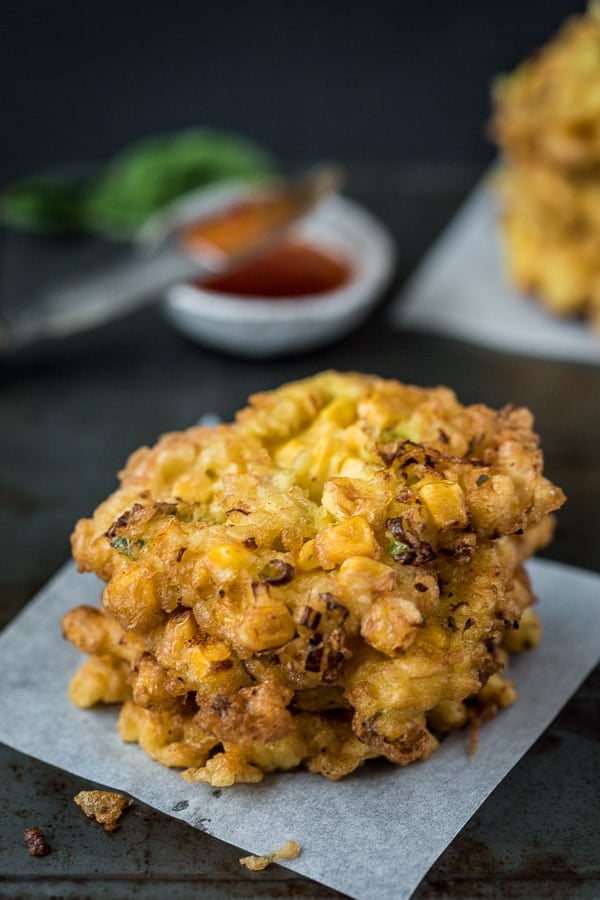
Why We Love This
These crispy, golden fried corn fritters are easy to make, with a deliciously savoury flavour and a satisfying crunch.
This generous recipe will make enough Indonesian corn fritters to feed a horde of hungry foodies! It’s also easy to adapt to suit your taste, or double it to feed even more.
The batter can be made in advance, and leftover corn fritters can be frozen and re-heated for another delicious feast.
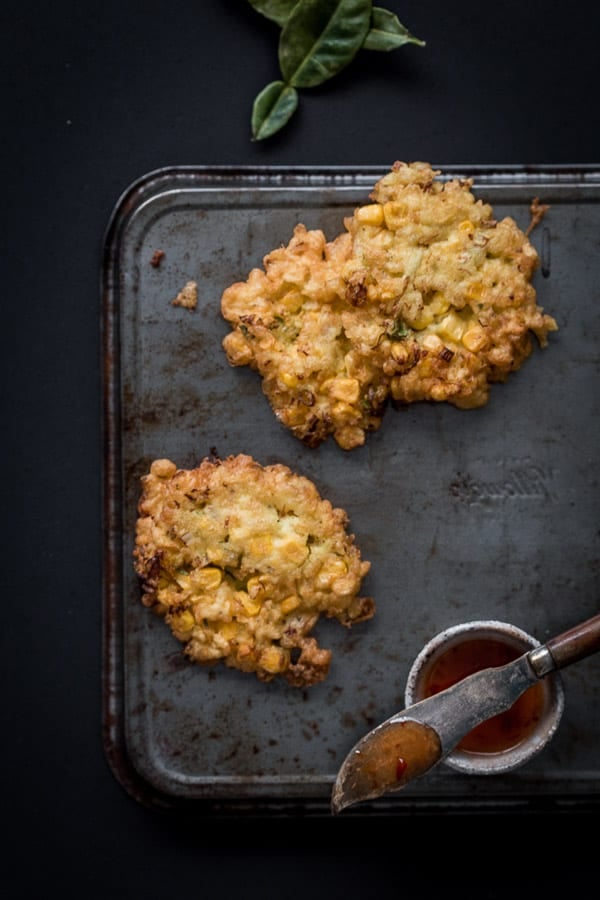
What is Bakwan Jagung?
Bakwan in English means vegetable fritter snack, while jagung means corn. Corn fritters are a super popular street snack in Southeast Asia, especially in Indonesia, where they’re also known as perkedel jagung. You’ll usually find them sold by street vendors, who whip up and fry these tasty snacks on the street or at local food markets.
Where We Learned This Recipe
This recipe for Bakwan Jagung (Indonesian Corn Fritters) comes to you by way of a little detour through Kagoshima, Japan.
The popular university town sees people flying in from all over the world to study, and we happened to make friends with a group of Indonesian students while staying with our amazing airbnb hosts.
One night they invited us to play angklung – a type of musical instrument made from bamboo – at the University. There were so many languages flying around the room, that at one stage, we were mixing Indonesian, Japanese and English words all together in one sentence. Thankfully everyone understood each other!
A few days later they invited us to a huge gathering with the expat community for a home-cooked feast – and to teach us a few of their delicious Indonesian recipes!
While the men were in charge of cooking Sate Lilit (minced pork skewers) on tiny charcoal stoves (panggangan), the ladies taught us their treasured recipes. Together we created a feast of epic proportions! There were bowls of fluffy white rice, spicy Sambal Telur (boiled eggs in hot chilli sauce), platters of Gado Gado (steamed veggie salad with peanut sauce) and these delicious golden-fried corn fritters.
With our plates piled high with tasty food and enjoying such amazing company, we could almost have forgotten we were still in Japan!
What You’ll Need
You’ll need a few pantry staples and some fresh veggies for these crispy little fritters:
- Flour – Regular / all-purpose flour forms the base for the batter. We then add rice flour which helps make the cooked fritters extra crispy! You can substitute rice flour for tapioca flour or corn starch.
- Veggies – We use canned corn kernels which is easier than slicing fresh corn off the cob, along with fresh shallots, garlic, fresh kaffir lime leaves, cabbage and spring onions (green onions). Feel free to add julienne carrots for crunch or chilli for colour and heat.
- Seasonings (aka bumbu) – This recipe uses a simple mix of turmeric, salt, pepper and sugar to taste.
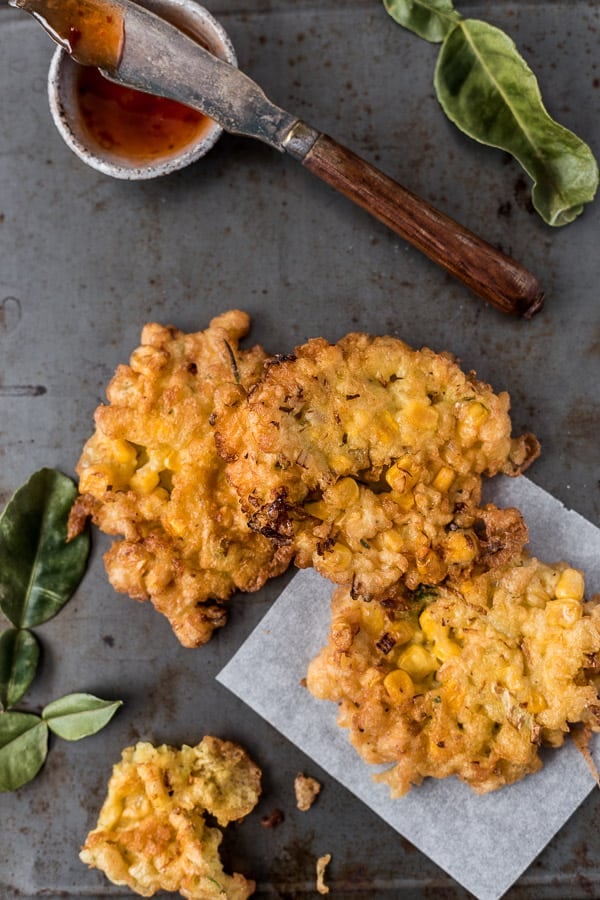
Wandercook’s Tips
- Peanut oil or canola oil are the best choices for frying corn fritters because of their high smoke points. This helps the fritters cook faster and creates a seal to stop the oil soaking through into the batter.
- Corn fritters can be served warm or at room temperature depending on your preference.
- Avoid overcrowding the pan when cooking. Give each fritter plenty of space to cook evenly.
FAQs
Indonesian style corn fritters include salt, pepper and sugar to taste, as well as ground turmeric, which gives these corn fritters their delicious golden colour. But you could also add ground coriander and/or candlenuts (or macadamia) for a deeper flavour. If using candlenuts, it’s a good idea to toast them in a dry fry pan until a darker colour then blend in a food processor before adding to the rest of the ingredients.
Yes, corn fritters can be frozen and reheated in a toaster or frying pan. If possible, avoid microwaving as this will make them soggy.
Yes, just like pancake or waffle batter, you can make the corn fritter batter up to two days in advance. We often cook half the fritters for lunch, storing the other half of the batter in the fridge to cook up a fresh batch the next day.
The batter is intentionally quite runny, as this ratio makes the fritters crispy once cooked. However if your batter is still too runny, you can add more flour a little at at time until you are happy with the texture. Note that if you add too much flour, your fritters might be softer rather than crispy, more like a pancake. But they’ll still be just as delicious!
Variations & Substitutes
- Corn – You can use freshly boiled corn to make bakwan jagung if you prefer – if so, just slice it straight off the cob and pop it into your batter.
- Kaffir Lime Leaves – Even though you can buy dried leaves, they are much better fresh. If you can’t find them, just leave them out.
- Add Extra Veggies – Traditional ingredients include bean shoots, shredded cabbage, julienne carrots and green beans.
- Add Protein – Try adding finely diced chicken (ayam) or shrimp (udang/ebi)
Dipping Sauce Ideas
Our Indonesian friends loved dipping theirs in tomato sauce/ketchup, or sambal (chilli sauce), but we also love them with:
- Kecap manis (Indonesian sweet soy sauce) – just a drizzle, as it’s quite concentrated. If you can’t find it locally, it’s easy to make kecap manis at home.
- Sriracha or Thai sweet chilli sauce – quick, easy and spicy!
- Homemade Vietnamese dipping sauce (nuoc mam cham).
- Spicy Korean choganjang sauce from our homemade potato pancakes.
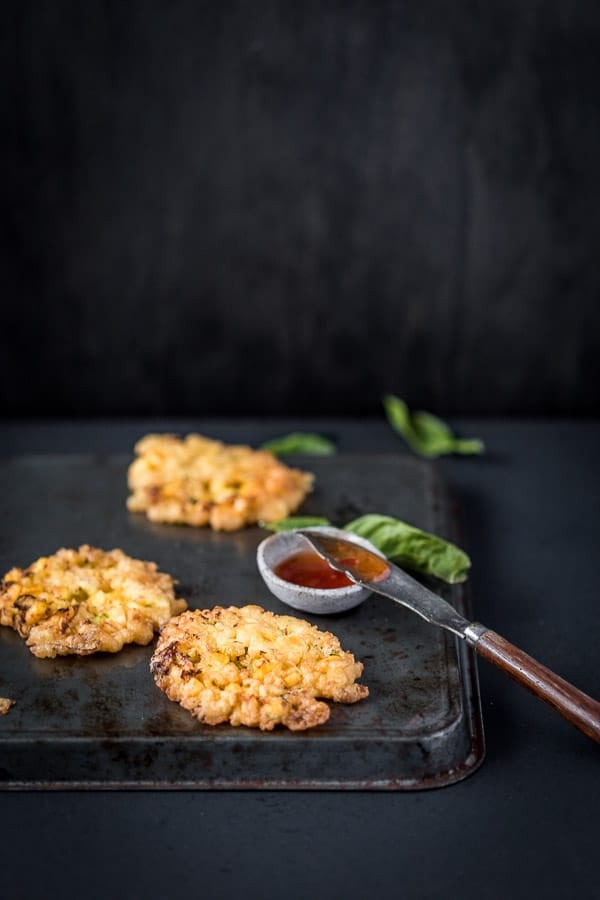
Want more colourful Indonesian recipe ideas? Try these:
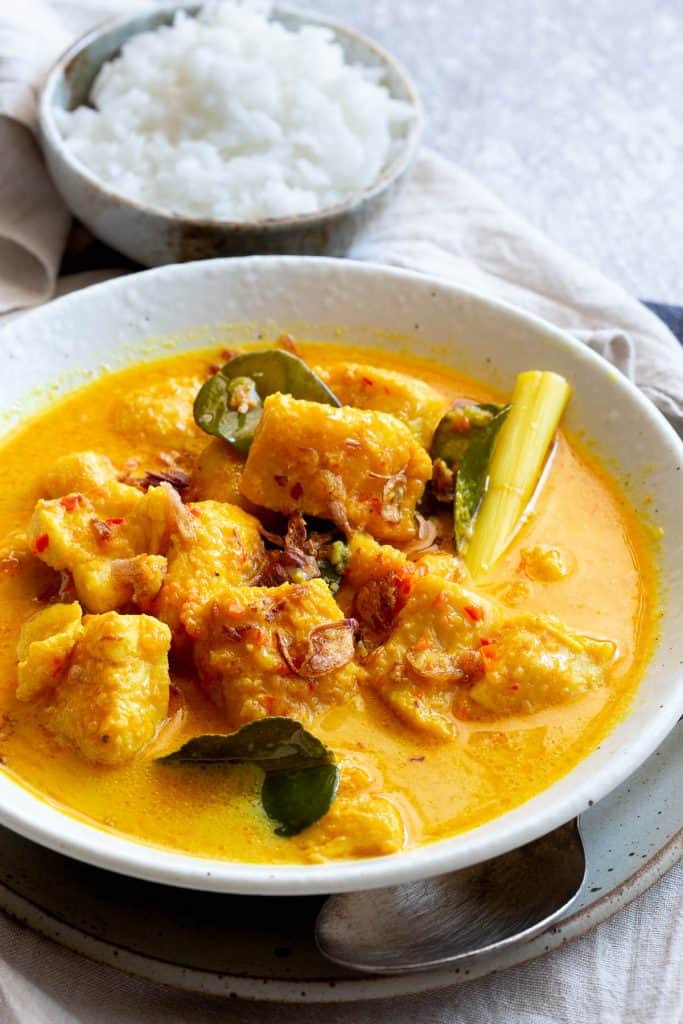
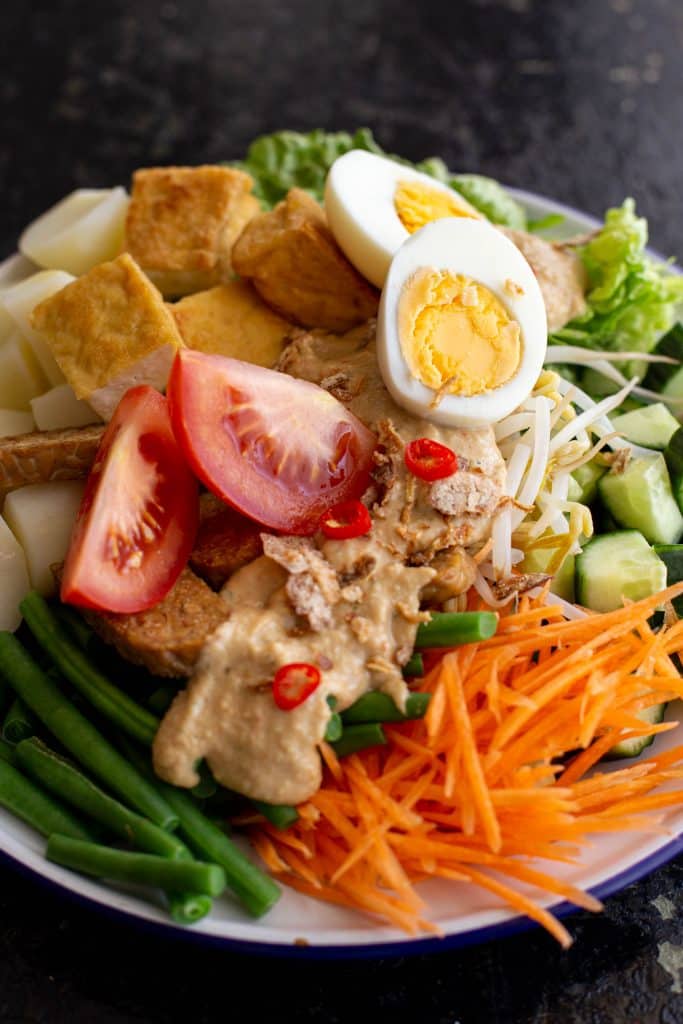
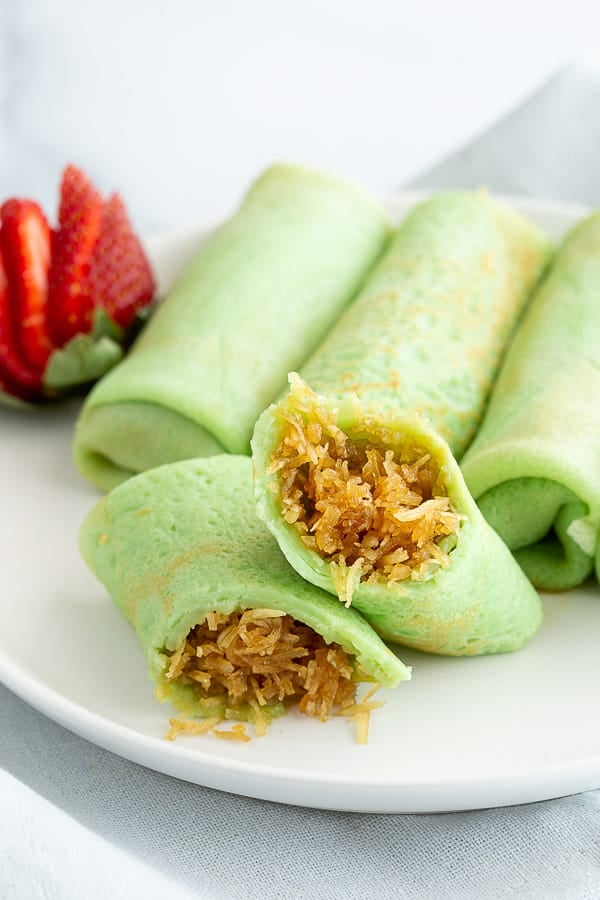
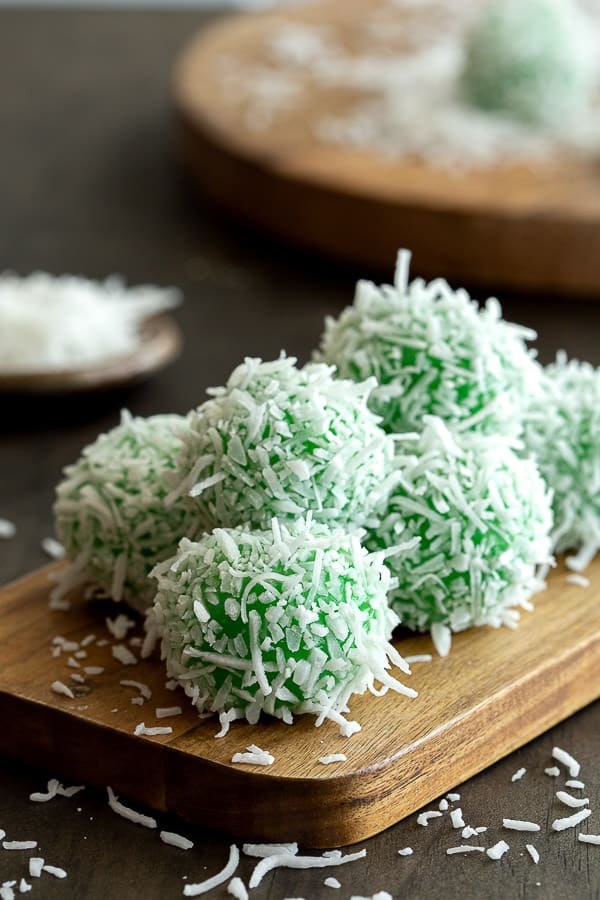
★ Did you make this recipe? Please leave a comment and a star rating below!
Equipment
Ingredients
Dry ingredients:
- 400 g corn fresh or canned
- 1 cup plain flour / all purpose flour
- ¾ cup rice flour
- 10 shallots finely chopped
- 3 – 5 cloves garlic finely chopped
- 2 Thai makrut / kaffir lime leaves finely chopped
- 2 cabbage leaves thinly sliced
- 2 spring onion / green onion thinly sliced
- 1 tsp turmeric
- Salt and pepper to taste
- sugar pinch to taste
Wet ingredients:
- 300 ml water
- 3 eggs
Oil for cooking:
- 1 cup vegetable oil for frying, or more as required
Dipping sauce options:
- 1 tbsp tomato sauce / ketchup
- 1 tbsp sriracha
- 1 tbsp kecap manis / sweet soy sauce
Instructions
- Place all of the dry ingredients in a big bowl then give it a quick stir. Next, make a well in the middle and crack in the eggs. Slowly start to mix, adding in water little by little until it's mixed into a thin and runny batter. Note: If it's too thick, you won't get that satisfying crunch, so thinner is definitely better.400 g corn, 1 cup plain flour / all purpose flour, ¾ cup rice flour, 10 shallots, 3 – 5 cloves garlic, 2 Thai makrut / kaffir lime leaves, 2 cabbage leaves, 2 spring onion / green onion, 1 tsp turmeric, Salt and pepper, sugar, 3 eggs, 300 ml water
- Now heat up the vegetable oil in a large frying pan or wok. You’ll know the oil is hot enough when bubbles appear around a toothpick dipped in the oil.1 cup vegetable oil
- Drop a ladleful of batter into the hot oil (carefully!) and fry until the batter turns a mouth-watering golden brown, about 2-3 minutes each side. Feel free to deep-fry a few fritters at a time if you have the space.
- When fritters are cooked, scoop them out of the oil and drain on a wire rack or paper towel. Sprinkle with salt to taste. Keep cooking until all the batter has been used up.
- Serve hot and crispy with tomato sauce, chilli sauce or kecap manis.1 tbsp tomato sauce / ketchup, 1 tbsp sriracha, 1 tbsp kecap manis / sweet soy sauce
Recipe Notes
- Corn – You can use freshly boiled corn to make bakwan jagung if you prefer – if so, just slice it straight off the cob and pop it into your batter.
- Kaffir Lime Leaves – Even though you can buy dried leaves, they are much better fresh. If you can’t find them, just leave them out.
- Flour – Regular / all-purpose flour forms the base for the batter. We then add rice flour which helps make the cooked fritters extra crispy! You can substitute rice flour for tapioca flour or corn starch.
- Veggies – We use canned corn kernels which is easier than slicing fresh corn off the cob, along with fresh shallots, garlic, fresh kaffir lime leaves, cabbage and spring onions (green onions). Feel free to add julienne carrots for crunch or chilli for colour and heat.
- Seasonings (aka bumbu) – This recipe uses a simple mix of turmeric, salt, pepper and sugar to taste.
- Cooking Oil – Peanut oil or canola oil are the best choice for deep frying corn fritters because of their high smoke points. This helps the fritters cook faster and creates a seal to stop the oil soaking through the batter.
- Add Extra Veggies – Traditional ingredients include bean shoots, shredded cabbage, julienne carrots and green beans.
- Add Protein – Try adding finely diced chicken (ayam) or shrimp (udang/ebi)
- Avoid Overcrowding – Give each fritter plenty of space in the pan to cook evenly.
Nutrition
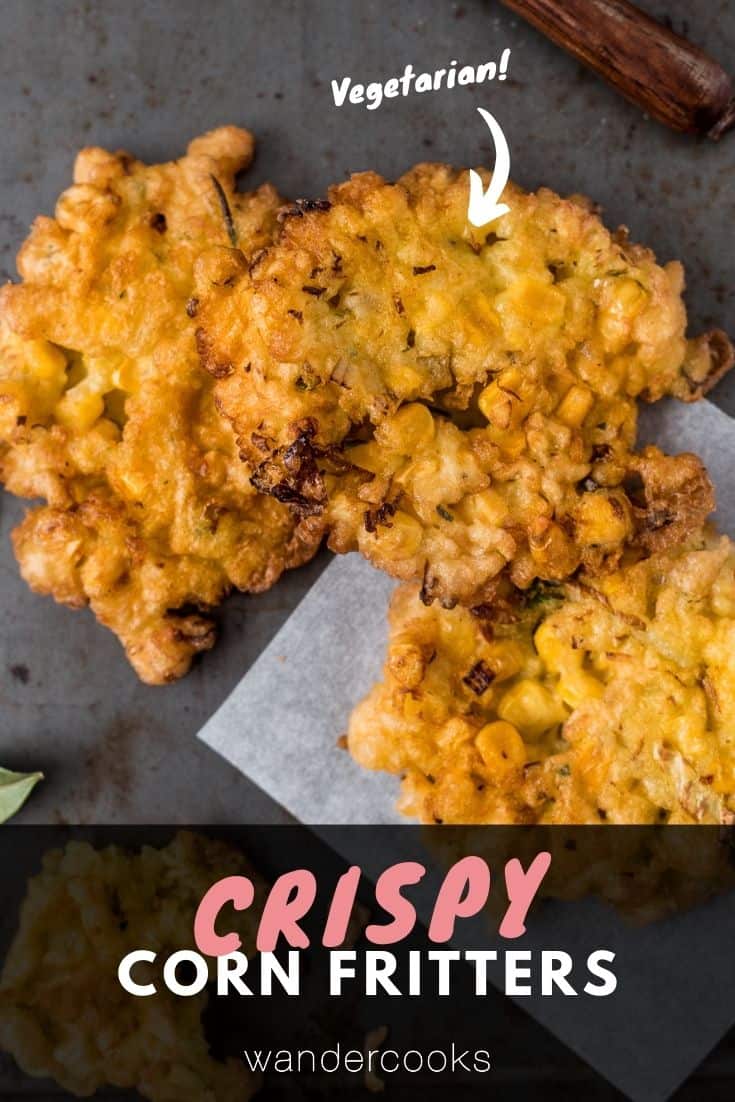

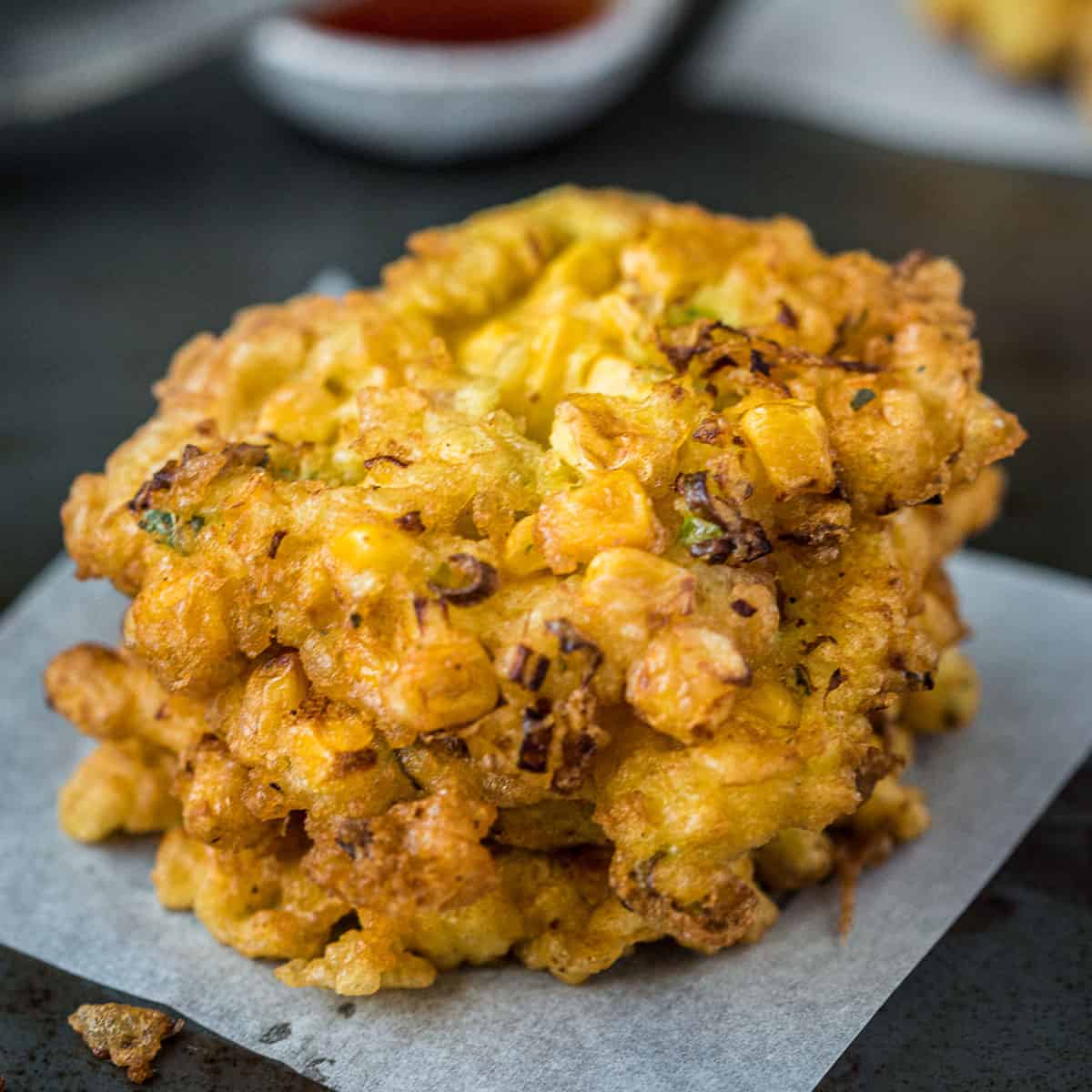


18 Comments
Siti
26/04/2022 at 9:24 amMy partner made this today and it is delicious! Tastes very similar to the ones I had at home. My partner speaks English and he was very excited about your blog since all the recipes I use are in Indonesian :P.
I wanted to say thank you for compiling so many recipes from all over the world and treating them very well. We’re excited to try other recipes from your blog, especially the Aussie sausage rolls!
Salam and terima kasih <3
P.S. bakwan = flour fritter (almost always vegetable), perkedel = potato fritter (pretty much mashed potato shaped like a ball, flattened, dipped in egg and fried)
P.P.S. klepon = small green glutinous rice balls with palm sugar inside, onde-onde = large glutinous rice balls with mashed mung beans inside and covered in sesame (there is a chinese version (Jian Dui) that is identical except they're filled with red beans)
We sometimes have different names for very similar things, I know it gets confusing :P. I've lived in Canada for years now and still forget the difference between ketchup/tomato paste/tomato sauce/crushed tomato/diced tomato :D.
Wandercooks
11/05/2022 at 1:38 pmSo good Siti! The words can definitely vary from area to area, although our Indonesian friends definitely refer to them as both bakwan / perkadel and klepon. There will always be variations though!
Jill
16/03/2022 at 4:16 pmI adapted a bit for what I had on hand, added lots of chilli, and garlic and regular chives. Made some soy, life chilli sauce. I had charred corn for something else, so used that. The only problem I had was there were supposed to be some left over for tomorrow. Oh well there is still corn at the market. This will be on rotate.
Wandercooks
24/03/2022 at 8:07 pmSounds incredible Jill, thanks for sharing. Sorry to hear about no leftovers ;), definitely time for another batch hehe.
Gatot Hadi
25/09/2020 at 10:47 amThank you for highlighting recipes from Indonesia.
On behalf of the population, we’re honored to be featured on your magnificent website.
The new hype in town recently is Indonesian kaffir lime rice, people usually eat it with sides and usual Indonesian protein.
Once COVID is under control and you guys are able to globetrekking, let me know if you happen to be in (my) town, Jakarta. I’ll be your one/two days guide and take you to the less publicised spot with awesome food in here.
Wandercooks
28/09/2020 at 9:24 amTerima kasih atas rekomendasinya! Kami sangat senang. We will definitely need to try the Indonesian kaffir lime rice, it sounds delicious!
That would be so amazing to visit you in Jakarta one day, it’s a city we’ve never been to but definitely want to explore. Just saw on your instagram that you’re a yoga instructor too – I (Laura) love yoga and if you’re keen it would be so fun to practice together too! Til then, stay safe and happy. x
melissa
28/11/2016 at 8:51 pmI love these! I lived in SE Asia and now I’m forever jonesing for a food fix from the region – absolutely incredible flavors with just simple ingredients.
Wandercooks
30/11/2016 at 9:27 amI know it’s incredible isn’t it Melissa? Amazing what you can achieve with simple, natural ingredients, and almost nowhere does it better than SE Asia!
John
29/05/2019 at 11:04 amCan you please tell me what is meant by two cabbages? What kind, how large, maybe in terms of cups?
Wandercooks
06/06/2019 at 11:42 amHi John, thanks for stopping by. It’s only two cabbage leaves, not whole cabbages. We used savoy cabbage, but you could also use wombok instead. It’s completely up to you! 🙂
Dannii @ Hungry Healthy Happy
28/11/2016 at 8:39 pmI don’t know much about Indonesian food, but what I have tried I have loved! I am going to have to try these next.
Wandercooks
30/11/2016 at 9:26 amThere’s so much flavour and spice to explore in Indonesian Cuisine – happy foodie adventuring! 🙂
valentina
28/11/2016 at 3:20 pmWhat a delicious recipe — I’m a huge corn fan and these sound over-the-top! And your photographs are so beautiful!
Wandercooks
30/11/2016 at 9:26 amCheers Valentina, glad you like them! 🙂
Christina | Christina's Cucina
28/11/2016 at 2:28 pmOooh, I adore corn! These look and sound fabulous! Will have to give them a try! Thanks for the recipe!
Wandercooks
30/11/2016 at 9:25 amUs too Christina, always love it when there’s leftover corn you don’t need in a recipe – we’ll literally eat it by the spoonful. 😛
Geoffrey @ Spoonabilities.com
28/11/2016 at 12:54 pmThese look delicious. I’ve never had these before. Must try!
Wandercooks
30/11/2016 at 9:24 amThanks Geoffrey, get ready for the awesomeness! 😛